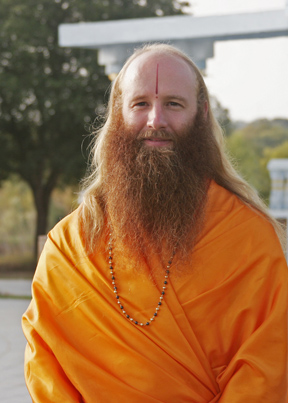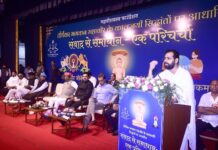 The previous article (Studying Gita on one’s own engenders pride) explained the qualification for studying the Gita. We are now ready to start learning the main topics of the first chapter of the Gita, starting with the first verse.
The previous article (Studying Gita on one’s own engenders pride) explained the qualification for studying the Gita. We are now ready to start learning the main topics of the first chapter of the Gita, starting with the first verse.
The first word of the Gita (chapter 1, verse 1) is ‘dharmakchetre’, which literally means ‘in the field of dharm’. At the time Shree Krishna spoke these words, He was at the battleground of Kurukchetra; so it might seem obvious that the ‘field of dharm’ He was referring to was Kurukchetra where a dharmic war was about to take place.
However, the ‘field of dharm’ refers not only to Kurukchetra, but also to the world as a whole. The whole world being the field of dharm is an integral concept of Hindu philosophy. You could also say that the whole world is the field of karm – both ideas are interrelated. That is why this world is also referred to as our ‘Karm bhoomi’.
The Field of Karm
The world we live in is the field of karm because as long as we are here in this world, we are bound by the law of karm. The world functions according to the law of Karm. The law of karm means that whatever actions we perform, anywhere in this world, we must receive the consequences. We are ‘bound’ by this law, because there is no escape from it and no way to circumvent it.
Wherever we go in this world, the spiritual government (God) is watching our every thought, word and deed, categorizing all of it as good or bad (according to the intention behind it) and then arranging for us to receive the consequences in the form of good or bad destiny (in our future lives). In other words, one can say that every action has a ‘karmic’ reaction. Since this world is the field where we perform our actions, and it is the field in which we receive the consequences, hence it is the field of karm.
The Field of Dharm
This whole world is also called the field of dharm, because not only are we being held accountable for all our karm, but there is a recommended course of action for us. That recommended course of action is called dharm. If we follow dharm, then we move in a positive direction – we improve ourselves. If we do not follow dharm, then we move in a negative direction. So living in this world is an opportunity to improve ourselves by following the path of dharm as recommended in the Vedas. Thus, it is called the field of dharm (for more information on the Vedas and dharm, see “The Gita Chapter 1, Part 1”).
Dharm is of two kinds: the recommended actions for living a good life in the world, and the recommended actions for attaining God. The first kind of dharm is called apar dharm and leads to peace of mind in this life and improved prosperity in the next life. The second kind of dharm is called par dharm and leads to God realization, the attainment of ultimate Bliss, and freedom from rebirth.
While apar dharm is limited to this transitory world and can only give temporary happiness, it is nonetheless important because it regulates people’s behavior so there can be peace and harmony in the family and society.
Yet, it is still only a preliminary dharm. If someone wants everlasting, perfect happiness, then they must graduate to the par dharm. This is the path to God, also called bhakti. It is the supreme dharm of all the souls, and it is the main topic of the Gita, which will be discussed in detail in later chapters.
In the next article, I will discuss why Arjun was confused about what his dharm was, and what the relationship is between duty and attachment.
Disciple of Shree Kripaluji Maharaj:
Swami Nikhilanand Ji is a Canadian born Hindu spiritual leader based in Austin, Texas. He is a sanyasi disciple and pracharak of Jagadguru Shree Kripaluji Maharaj.
Attracted to the teachings of Hinduism from a young age, Swamiji eventually let his deep spiritual longing lead him to India, where he was most fortunate to come under the guidance of Shree Kripaluji Maharaj. Thereafter, living in the ashrams of JKP, he extensively studied Hindi, the philosophy of the prime Sanskrit scriptures (Vedas, Darshan Shastras, Gita, Bhagwatam), and practiced meditation in the tradition of raganuga bhakti. In 2003, he was given sanyas.
Now, with the blessings of his Guruji, he offers satsang programs throughout America, engaging audiences with his clear explanations of Hindu philosophy coupled with inspired chanting of Sanskrit mantras and shlokas and charming nam sankirtan. His informative and compelling speeches provide practical insight into how to adopt the teachings of Sanatan Dharm into our daily lives, and inspire us to awaken our inner spiritual potential.
To stay in touch with Swami Nikhilanand Ji, like his Facebook page at https://www.facebook.com/SwamiNikhilanand or follow him on twitter at https://twitter.com/Swami_Nikhil.
Swami Nikhilanand






